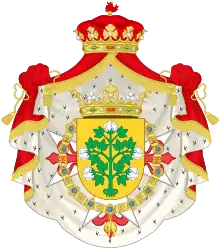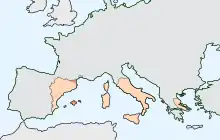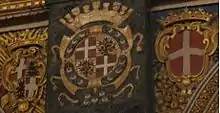House of Cotoner
The House of Cotoner is a noble house distinguished in the service of the Spanish Monarchy until the 20th century.
| Cotoner | |
|---|---|
| Spanish nobility | |
 | |
| Country | Former countries
|
| Founded | c.1370 [1] |
| Founder | Bernardo Cotoner |
| Current head | Iñigo Cotoner y Martos Marquess of Mondejar (GOS) |
| Titles |
|
| Style(s) | "HMEH" (non-hereditary) "His Excellency" "His Illustriousness" |
| Estate(s) | Cotone, Castello di Monte Pò, Castello di Montorgiali, Castello di |
History
Italian origins
The house's origins go back to the Italian city state of Republic of Siena (Italy), also known as "Maggi di Cotone".
When the Cotoner family grew in numbers, some of its members left Tuscany and established branches in various other places. Some went to Ascoli, where they founded and built the Castle of Monte Pastillo and others to Sicily, where they held the principality of Castelnuovo and Santa Caterina, keeping the memory of their Signoria del Cotoné in the Republic of Siena.[2][3][4][5]
One of those branches was to become one of the so-called "Nou Cases" (meaning Nine Houses)[6] in the Kingdom of Majorca, for there were nine "nobilis et Antique familiae'". These nine families were also incorporated into the Nobility governing and legislative bodies, like all the other houses, of the Kingdom but differed by the quality of their lineage.[7]
Settlement in Majorca

Bernardo Cotoner is first documented in the Kingdom of Majorca when seting up a "beneficio" for the Parish of Santa Eulalia and the again on 1363, acquiring a farmhouse ("alqueria") in Valldemossa. On July 23rd, 1370 Letters patent were issued by Peter IV of Aragon confirming tax exception as well as their nobility for them participants in the conquest and his successors.[1]
His son Nicolas Cotoner y Genovard had three sons: Nicolas, Bernardo y Gabriel Cotoner y Saguals, setting up three distinct branches.[8] Bernardo Cotoner y Saguals earned on July 18th, 1463, for his merits and services, privilege for perpetuity in the "braç militar" of the Kingdom of Mallorca.[9]

It will be however, the great-grandson of Nicolas Cotoner y Saguals, Antonio Cotoner y Vallobar who will effectively consolidate the influence of the family. Antonio had been acting in the Res publica of his country, having demonstrated special talents and deserving the trust of the sworn representatives of the city and the Kingdom of Majorca to perform an important commission.[10] Perpetual privilege was issued in October 18th, 1569 effectively knighted 1572 by Philip II of Spain.[1]
Of special relevance, is the historic and close relationship of this family with the Knights Hospitaller also known as Order of Malta with the ascension of Raphael and Nicolas Cotoner to the sovereign dignity of Grand Masters.[11]
Notable members
- Antonio Cotoner y Vallobar, (born 1518), Nuncio or extraordinary Ambassador of the Kingdom of Majorca in 1571,[12] and facilitated the royal sanction to establish a "Real Audiencia'" in Majorca. He was issued perpetual privilege to nobility in October 18, 1569 and was knighted by Philip II of Spain own hands in 1572.[13]
- Bernado Luis Cotoner y Ballester (*1571 +1641), son of Antonio Cotoner y Vallobar in his second marriage[14] he dedicated his life to the study of law, and at the University of Avignon received his Tassels both in Canon law and Roman Law.[15] In good age he joined the Ecclesial Estate. Member of the Dominican Order, he came to be Apostolic Inquisitor of the Kingdom of Sardinia, General Inquisitor in the kingdoms of Majorca, Aragon, Valencia and in the County of Barcelona. He died in 1641 when acting as "visitador" to the Holy office in Sicily.
- Fra' Rafael Cotoner y Oleza; 1601 – 20 October 1663) was the 60th Grand Master of the Knights Hospitaller or, as it is already known by that time, the Order of Malta, serving in that position from 5 June 1660 to his death on 20 October 1663 following the brief reign of Annet de Clermont-Gessant.[16] After his death, he was succeeded as Grand Master by his brother, Nicolas.
- Fra' Nicolas Cotoner y Oleza; 1608, Mallorca – 29 April 1680, Malta) was the 61st Prince and Grand Master of the Order of Malta, between 1663 and 1680. He was the son of Marc Antoni Cotoner i de Santmartí and brother of the previous Grandmaster, Rafael Cotoner.[17]
- Marcos Antonio Cotoner y Sureda[18] (1665-1749), was a spanish noble, politician and military. 1st Marquess of Ariany and I Regidor of Palma de Mallorca following the Nueva Planta decrees issued by Philip V of Spain.[19]
- Fernando Cotoner y Chacón[20] (1817-1888), 1st Marquess de la Cenia, GOS, OCIII, KOC, Lieutenant at the Carlist Wars, Governor of Puerto Rico,[21] interim Minister of War and Director general of the Civil Guard.[22]Captain General of the Balearic Islands. Senator for life for the Balearic Islands.[23]
- Nicolás Cotoner y Cotoner, 23rd Marquess of Mondéjar, 25th Count of Tendilla, 7th Marquess of Ariany, GOS, KOGF, OCIII, KOC, OM (19 October 1905 – 6 March 1996), was a Spanish nobleman and military officer, head of the Royal Household of Spain under Juan Carlos I, from 1975 to 1990.[24]
External links
- Notes & Queries, Volume 9: Letters from Charles II of England to Fra' Nicolás Cotoner.
- Times of Malta: Cappella Musicale Pontificia, concerti straordinari.
References
- Pardo Manuel de Villena, A. (1932). «Grandes Maestres de la Orden de Malta pertenecientes a las Lenguas de Castilla y Aragón en los siglos 17 y 18 y su intervención en la política internacional de la época». Recepción Pública en la Real Academia de la Historia (Página 42).
- Guida alla Maremma mediavale 12. Cotone (P.169-174) "Il castello di Cotone, che non figura nelle spartizioni dei centricontrollati dagli Aldobrandeschi nel XIII secolo, era all’epoca do-minato da un gruppo signorile locale, che nel primo Trecento ri-sulta strettamente legato ai cosiddetti “Conti di Montorgiali”, unaconsorteria nobiliare rurale che nei decenni centrali del Duecentoagiva nell’area in sintonia con il Comune di Siena, contrapponen-dosi agli Aldobrandeschi di Sovana-Pitigliano. Una sottomissione al Comune di Siena in cui si fa esplicita men-zione del castello di Cotone, comunque, si realizzò solo negli ul-timi anni del governo popolare dei Nove, quando nel 1351 la famiglia signorile discendente dai “conti di Montorgiali”, vale a dire i “Maggi – del Cotone”, sottomise al Comune di Siena questo ca-stello unitamente, appunto, a quello di Montorgiali. Nel 1378 gliesponenti del medesimo gruppo familiare alienarono più consi-stenti diritti giurisdizionali sul castello e sul territorio di Cotone alComune di Siena, che prese possesso, tra l’altro, della “torre delcassero” e di un “palazzo” nella “fortezza” del castello. Pochi annidopo, nel 1385 il Cotone venne occupato dalle masnade dellacompagnia militare dei Bretoni, unitesi a quelle del magnate seneseribelle Spinello Tolomei, sino a che l’esercito di Siena, appoggiatodalle truppe dei Salimbeni, magnati antagonisti dei Tolomei per ilpredominio sul governo senese, occuparono nuovamente il centro."
- Storia di Montepulciano - La città e i suoi misteri di Mario Morganti
- Mango di Casalgerardo, Antonino (1915). Il Nobiliario di Sicilia, Volume 2 (in Italian). Forni. pp. 54, 244 y 299. ISBN 0341643203, 9780341643203 Check
|isbn=value: invalid character (help). Retrieved 15 April 2019.Godette nobiltà in Messina ed in Palermo. Possedette i principati di Castelnuovo e di Villermosa, i marchesati di Altamira e di Analista, le contee di Bavuso e di Naso, le baronie di Linguaglossa, Rapani, Fiumefreddo, San Basile, Lauro, Giardinello ecc.
- Cottone (familia de Sicilia)
- Introducción al estudio de "Sea Nou Cases" (in Spanish)
- MONTANER, P. y PORQUERE, E.: Subendogamias en el Mediterráneo, los ejemplos mallorquines de la Aristocracia y de los descendientes de los judíos, Palma 1989, Estudics Balearics, nº 34 p. 82 (in Spanish)
- Enciclopedia.Cat - Ref Cotoner y Saguals (in Catalan)
- Nobiliario de los reinos de España - Ref. Ciudadano Militar del Reino (in Spanish)
- "Biblioteca Digital deles Illes Balears - Bolletí Societat Arqueologica Lulliana (Pag 149) {{in lang|es}}" (PDF). Archived from the original (PDF) on 2016-03-04. Retrieved 2019-03-24.
- Biblioteca Digital deles Illes Balears - Bolletí Societat Arqueologica Lulliana (p. 312) (in Spanish)
- La Justicia en el Antiguo Reyno de Mallorca - Ref. Antonio Cotoner (in Spanish)
- Nobiliario de los reinos y señoríos de España - Ref. Antonio Cotoner (in Spanish)
- "Biblioteca Digital de les Illes Balears, p. 219 {{in lang|es}}" (PDF). Archived from the original (PDF) on 2016-03-03. Retrieved 2019-03-31.
- Biblioteca de Escritores Baleares - Ref. Bernardo Luis Cotoner (in Spanish)
- "Rafael Cotoner y de Oleza - The 60th Grandmaster of The Sovereign Military and Hospitaller Order of St. John of Jerusalem of Rhodes and of Malta".
- Richards, Brian (2008). Malta (5 ed.). New Holland Publishers. p. 65. ISBN 978-1-84537-871-4.
- Cronicón Mayoricense, noticias y relaciones históricas de Mallorca desde 1229 a 1800 - ref.Marcos Antonio Cotoner y Sureda (in Spanish)
- Comentarios de la guerra de España, e historia de su Rey Felipe V - ref. Marcos Antonio Cotoner y Sureda (in Spanish)
- Ref. Fernando Cotoner y Chacón(in Spanish)
- Puerto Rico y su historia íntima,<rc-c2d-number> 1500-1996</rc-c2d-number>: Siglos XIX y XX - Ref.Fernando Cotoner y Chacón (in Spanish)
- Ref - El Teniente General Fernando Cotoner y Chacón, Marqués de la Cenia (in Spanish)
- Senado - Expediente personal de Fernando Cotoner y Chacón (in Spanish)
- Los jefes de Casa del Rey (in Spanish)